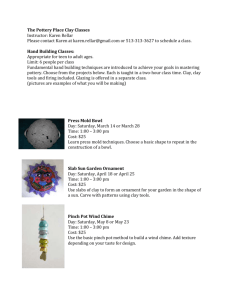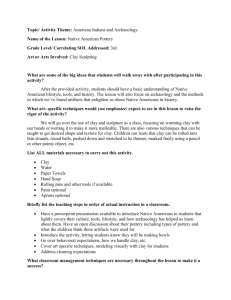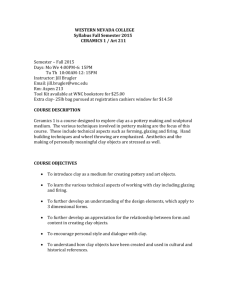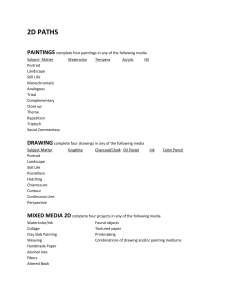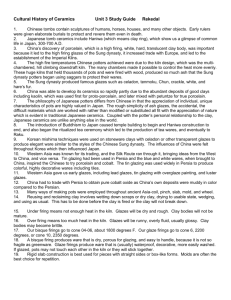Pottery 11 - School District 67
advertisement
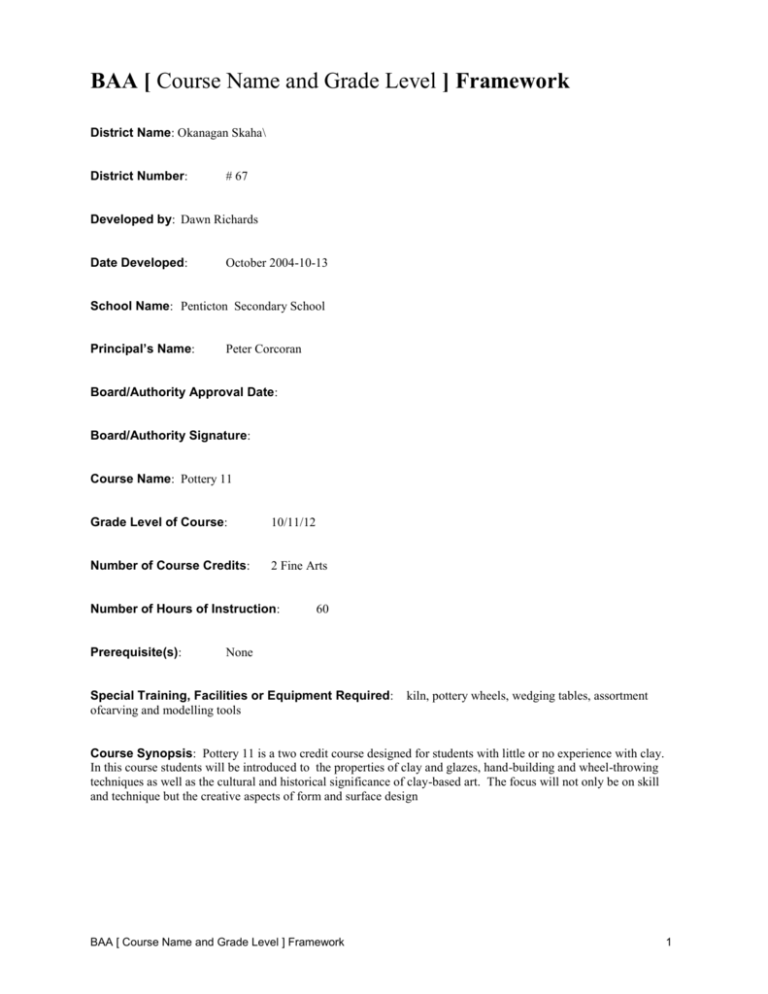
BAA [ Course Name and Grade Level ] Framework District Name: Okanagan Skaha\ District Number: # 67 Developed by: Dawn Richards Date Developed: October 2004-10-13 School Name: Penticton Secondary School Principal’s Name: Peter Corcoran Board/Authority Approval Date: Board/Authority Signature: Course Name: Pottery 11 Grade Level of Course: 10/11/12 Number of Course Credits: 2 Fine Arts Number of Hours of Instruction: Prerequisite(s): 60 None Special Training, Facilities or Equipment Required: ofcarving and modelling tools kiln, pottery wheels, wedging tables, assortment Course Synopsis: Pottery 11 is a two credit course designed for students with little or no experience with clay. In this course students will be introduced to the properties of clay and glazes, hand-building and wheel-throwing techniques as well as the cultural and historical significance of clay-based art. The focus will not only be on skill and technique but the creative aspects of form and surface design BAA [ Course Name and Grade Level ] Framework 1 Rationale: The main goal of the Pottery 11 is to provide students with a creative course that will fit into a 60 hour format. Many students enjoy exploring their creative side but find it difficult to squeeze a 4 credit course into an already packed timetable. Pottery also provides students who are insecure about their drawing skills to create with a medium that is versatile and very tactile. I have offered Pottery as a course and as a club for 4 years and students discover that they take pride in making things by hand. Organizational Structure: Unit/Topic Unit 1 Unit 2 Unit 3 Unit 4 Unit 5 Title Time Introduction to clay, history and safety issues Hand-building techniques Glazing Techniques Wheel throwing Techniques Sculpture 5 hours 15 hours 10 hours 15 hours 15 hours 60 hours Total Hours Unit/Topic/Module Descriptions: Unit 1: Overview: Introduction to clay: History and Safety Students will become familiar with how clay is formed, the historical influences and how the tradition of clay has been passed on through the centuries. Students will also learn important safety issues regarding handling of clay and glazes, use of equipment and proper clean-up of tools and studio. Students will be tested on this information as well as specific terminology associated with ceramics at the end of term. Curriculum Organizers Context: Students recognize historical, cultural and contemporary influences in ceramic art Learning Outcomes Students will be familiar with how clay is formed and its specific properties Students will demonstrate proper handling of equipment and materials Students will demonstrate importance of safe clean-up procedures . Unit 2: Overview: Hand-building Techniques Students will learn four main hand building techniques; Pinch Pot, Carving from a solid base, Coil and Slab. Students will create three projects using these techniques with the emphasis on creativity and craftsmanship. As students progress through these projects, they will learn about the five stages of clay and the possibilities and limitations of the medium. All work will be bisque-fired for glazing later. Curriculum Organizers Image development/Image strategies: Observation, Imagination/ Elaboration, Visual Elements and Principles: Form, shape, balance, line, texture Materials/Technologies and Processes: Clay stages, score and slip, coil, slab, stamping, incising Learning outcomes: Students will demonstrate knowledge of hand-building techniques in three projects Students will demonstrate understanding of the various stages of clay Unit 3: Overview: Glazing Techniques In this unit students will be shown two approaches to glazing ceramic; underglazing and dip glazing. Demonstrations on how to use underglazes and dip glazes for surface decoration and the reasons for glazing will be explored. Proper application of glazes and safety issues regarding dust and the importance of hand washing are stressed. Curriculum Organizers Elements and Principles of design: Colour, form, balance BAA [ Course Name and Grade Level ] Framework 2 Materials/technologies and Processes: Underglazes, kiln settings, dip glazes, Learning Outcomes: Students will demonstrate how to apply undergazes and dip glazes in a safe and effective manner Students will demonstrate proper set up and clean up procedures for the glaze station. Unit 4: Overview: Wheel Throwing Students will watch demonstrations on how to use the kick wheel and electric wheel to produce functional ceramic pieces. Step-by-step instruction on centering, opening, forming walls and forming will be shown and reinforced with written instruction and practical experience. Proper trimming techniques and handle making will also be covered. Curriculum Organizers: Materials/technologies and Processes: Kick and electric wheels, clay, forming tools, throwing procedure sheets. Context: The ages- old process of wheel throwing as demonstrated by Wayne Ngan (video) will be recreated by students using similar technology. Learning Outcomes: Students will demonstrate knowledge of wheel throwing techniques by producing two required assignments. Students will demonstrate proper finishing of pieces by trimming and glazing of work Unit 5: Overview: Sculpture The sculpture unit will involve students in producing non-functional art work using clay. This unit will require students to produce a three dimensional work using the hand-building techniques learned in Unit two. Demonstrations on building a paper armature and building a rough form before adding details will give students step by step instruction on creating large sculptural pieces. Students will design/plan their sculptures on paper before beginning. The work of Joe Fafard will be featured Curriculum Organizers: Image Development: Consider the clay sculpture of Joe Fafard; his influences and image sources Design. sculpture on paper ; consider three views. Visual Elements and Principles: form, texture, colour, space Materials. Technologies, Processes: clay, slab, armature, incising, carving Learning Outcomes: Students will using additive and subtractive sculpture techniques to create an original art work Students will plan ahead on paper to work out design before starting sculpture Instructional Component: Direct Instruction Demonstrations Note-taking Video Practical studio work Assessment Component: 75% of the grade will be based on projects and related work ( planning & tests) 25% of the grade will be based on studio participation; being prepared, being on time ,use of studio time and clean-up BAA [ Course Name and Grade Level ] Framework 3 Learning Resources: Videos; Wane Ngan; Reflections of Earth Joe Fafard Variety of visuals, posters, articles Additional Information: BAA [ Course Name and Grade Level ] Framework 4

